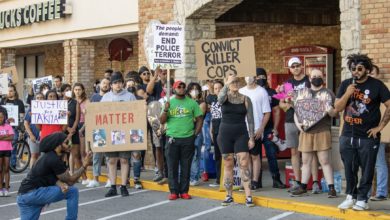 Lorena López, mother of Suzie Marie Peña Photo: Aurelia Ventura |
On July 10, 19-month-old Suzie Marie Peña was shot in the head after a nearly three-hour standoff between her father, José Raul Peña, and the notorious Los Angeles Police Department. The incident was caught by nine cameras recording a total of 27 hours of footage. Supposedly, none of this footage documented the murders of the little girl or her father.
Jose Peña had picked up his daughter from her mother’s home that morning to take her to his car dealership, in what Lorena López, Suzie’s mother, called “a daily routine.” A few minutes later, Lorena heard gunshots and ran to the car lot. She cried out to the cops on the scene, “Don’t shoot, my baby’s there, my baby, my baby, my baby.”
Her cries, echoed countless times in other Los Angeles oppressed communities, were ignored.
Peña held his daughter in one hand and exchanged fire with the cops with the other. The LAPD called the incident a “hostage situation,” but no negotiator was called. Instead, five officers stormed the office where José and Suzie were located. Eleven officers opened fire, leaving one police officer injured and both the father and his daughter dead.
Immediately, cops and the media tried to portray the police as victims and to vilify the father. Renowned racist Police Chief William Bratton referred to José as “a cold-blooded killer,” despite autopsy results proving that the bullet that went through Suzie’s head was shot from a cop’s gun. Bratton described the actions of the cops as “their lawful duty.”
Newly elected Mayor Antonio Villaraigosa, touted by some as a progressive, also attempted to validate the actions of the police. “Not a one of them went into that situation with the intent to hurt anyone,” he said.
Lorena Peña, Suzie’s mother, responded after the shooting by saying, “I don’t want an apology. I want justice.”
Smoke-screen investigations into the killing are on their way. But these investigations, like the many others over the years that have either exonerated the murderous cops completely or covered them up as “isolated incidents,” cover up the evident roles of the police in maintaining the exploitative conditions that exist in oppressed minority communities nationwide. Police brutality is an aspect of the daily struggle for Black, Latino and other oppressed nationalities across the country.
 Bill Hackwell |
Suzie Peña is a new name in a never-ending list of individuals killed or abused by the Los Angeles-area police. The list over the past few years is staggering. Margaret Mitchell, a 105-pound, 54-year-old African American homeless woman, was shot by a cop in 1999 after she allegedly waved a screwdriver at him. Months earlier, in December 1998, four Riverside, Calif. cops unloaded 23 bullets into 19-year-old Tyisha Miller, hitting her 12 times and killing her.
More recently, in June 2004, Stanley Miller, an unarmed 36-year-old Black man, was kicked while on the floor and hit repeatedly in the head with a metal flashlight. In February 2005, an LAPD officer shot 10 bullets into the back of 13-year-old Devin Brown in South Los Angeles, killing him instantly. Just three months later, sheriff’s deputies unleashed more than 120 bullets in a Compton neighborhood as they pursued Winston Hayes, an innocent Black man they claimed was involved in a crime. Hayes was hit with four bullets.
Killing sparks protests
Despite the propaganda campaign against José Peña, the South Central Los Angeles community mobilized in outrage. Two days after Suzie’s murder, protestors started to gather at the car dealership where they were both killed.
In the days that followed, the number of demonstrators increased. Hundreds were soon on the historic streets of Watts, militantly showing their readiness to confront the cops. Face to face with their oppressors, they vented their frustrations at the cops.
The LAPD was fearful that the protests would spark a mass rebellion like the one following the acquittal of cops who beat Black motorist Rodney King in 1992. At every night’s protest, hundreds of cops surrounded the demonstrators in a synchronized show of force. African American and Latino youth made up a vast majority of the protestors, a show of unity that discredited attempts at dividing the communities with overblown stories of racial tensions.
Demonstrators were quick to draw parallels between the racist cop killings and the war in Iraq. “The government says that it’s sending U.S. soldiers to fight terrorists over there, but we are facing police terrorism right here,” was a typical comment made by speakers at the demonstration.
The LAPD is conducting an inquiry into Suzie’s killing. But given the LAPD’s history of exonerating every murder and beating by the police, many community members fear that the inquiry will be another whitewash designed to justify the continued reign of violence.
Suzie Marie Peña and her father are two more victims in the list of thousands who have been killed by racist police violence. But the individual acts of violence by the cops and the state they serve become added fuel for future rebellions against racist oppression.
The Harlem rebellion in 1964, the Watts uprising in 1965, the Los Angeles uprising in 1992 and many others were sparked by individual acts of violence that exploded in mass rebellion against the hundreds of indignities and violence that is part of daily life in the oppressed communities across the United States.
Justice for Suzie Peña!





